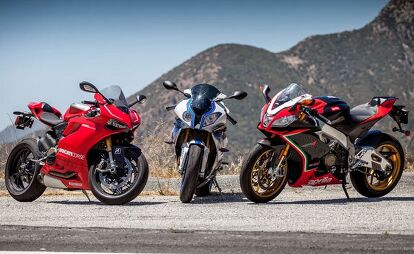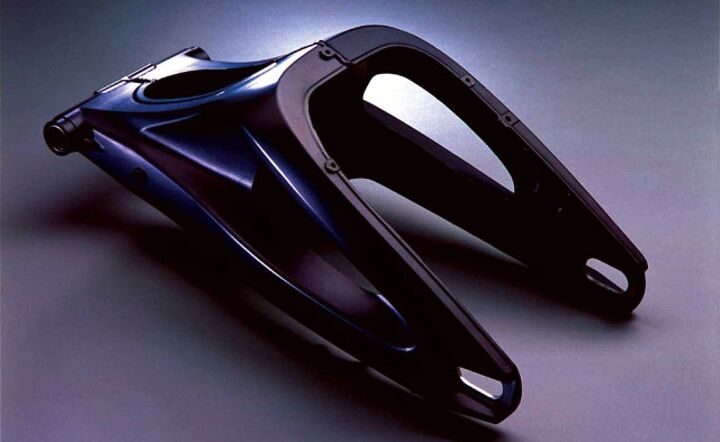Exploring Lightweight Materials On Motorcycles
Less is expensive
We’re all familiar with the “less is more” expression, and that also holds true in the weight/cost equation of motorcycle materials. Simply put, for a given strength and durability, a lighter component is a more expensive piece.
Consumers of all types prefer lower prices, but motorcycle engineers and enthusiasts are willing to pay more because less mass results in higher performance. A lightweight vehicle accelerates quicker, handles better and brakes harder. Consequently, motorcycle building materials have evolved through the decades to deliver lighter and stronger machines.
And residing at the pinnacle of mass-production sportbikes are the latest literbikes such as the Aprilia RSV4 Factory, BMW HP4, Ducati Panigale R we tested last summer in our Exotic Superbike Shootout. Heavy steel parts are almost non-existent, and instead we find aluminum, magnesium, titanium and liberal doses of carbon fiber – all materials that cost more than their heavier alternatives.
Read the street portion of our Exotic Superbike Shootout
To whit, the 1198cc Panigale R, which has a tank-empty weight less than 400 pounds. Incredibly, that’s about the same as a modern 600cc sportbike with half the Duc’s engine capacity. Also playing into this equation is the Duc’s princely $30K MSRP, more than double any 600.
That trio of high-end exotica illuminated the bleeding edge of lightweight motorcycle construction, reminding us how motorcycle build construction has evolved through the years. So, here we offer a retrospective on the history of the bones that build motorcycles.
Iron
Metallurgy was in its infancy in the late nineteenth century, so simple and relatively abundant iron was the metal of choice in the gestational stages of motorcycle development, especially engine components. Strong and relatively easy to cast, iron was eventually supplanted by lighter steel engine blocks and heads as metallurgic processes were advanced.
Steel
As the twentieth century loomed, alloyed steel became the choice material for the chassis of motorcycles. Relatively inexpensive and easy to work into various shapes, steel is employed for the vast majority of motorcycle frames in production today.
Aluminum
Long known as a lightweight metal, aluminum was a rarity until it was alloyed with other metals. The casting process for aluminum could be problematic, as pores in the cooled metal could cause terminal failure in one casting pour while the next pour might exhibit good durability. Engine materials eventually shifted from steel to the aluminum components in general use today.
It wasn’t until the 1980s that aluminum began to emerge as the preferred choice for the frames of high-performance motorcycles. Instead of relying on carefully bent and strategically gusseted steel tubing, aluminum could be cast into various complex components to construct a lightweight yet rigid chassis. Top-line contemporary sportbikes from every OEM now use aluminum as key parts of their chassis’ structures. Even some cruisers (Star Roadliner, Victorys, Indian Chiefs) sport alloy frames.
But die-casting aluminum is fraught with hidden peril. It’s common for gases and oxides to be trapped as the liquid aluminum is poured into its mold, and these gas bubbles can weaken the component’s structure, especially when heated. As such, cast-aluminum pieces were often built with extra fudge-factor tolerances, which made each casting heavier. If only engineers could figure out a way to remove the gases that were entrained in the poured metal…
This conundrum was mostly unraveled by the recent vacuum die-casting process in which gasses are evacuated from a casting by pressure-evacuating pumps while the aluminum is being poured. This reduces inclusions of gases and oxides in a finished aluminum part, yielding lighter pieces of the same strength to emerge and allowing easier welding or heat treating.
Vacuum-cast components first gained notoriety in the frames and swingarms of Yamaha’s R1 and R6. The OEM termed its method as Controlled Fill and claimed an 80% reduction in entrained gases. The process also allowed casting larger (hence, fewer) components, rather than welding together many individually cast pieces.
Other OEMs followed, and not just for frames. Low-pressure casting is also being used to produce engine crankcases, such as the Vacural process used in modern Ducati engines, including the Panigale’s.
Magnesium
This exotic metal first gained vehicle notoriety when implemented in race-car wheels – eventually aftermarket automotive wheels were given the mag-wheel moniker, or “mags,” even if they weren’t made from lightweight magnesium.
Actual mag wheels have long been used in grand prix motorcycle racing because they weigh about 30-35% less than aluminum hoops, but the porous nature of cast magnesium has all but prevented its use on streetbike wheels because of concerns over air pressure loss, debilitating corrosion and the possibility of being dented by potholes. Using a forging process, rather than simple casting, alleviated some of the concerns inherent with cast wheels, while new coatings improved corrosion resistance.
Magnesium’s lightweight properties remain relentlessly desirable to moto engineers, so it’s become relatively common in the past decade for non-structural components like valve and engine covers to pare ounces from sportbikes.
Magnesium also can be problematic to cast, as it loses heat quickly and must lack impurities if it is to optimally resist corrosion. Yamaha’s solution for the mag subframe of its R6 was to use the Controlled Fill method (including controlling the temperature of the die and injecting the molten metal quickly, resulting in a thin-wall, high-purity structural component that is lighter than a comparable aluminum part.
Titanium
Strong as steel but as much as 75% lighter, titanium boasts the highest strength-to-weight ratio of all metals. First seen in 1950s military aviation, ti’s compressed structure (60% denser than aluminum) gives it more than double the strength of conventional aluminum alloys. But titanium is difficult and costly to extract and process, resulting in prices at least six times that of aluminum.
Ti’s high price has limited its use in motorcycles despite the tangible benefits of using lighter-weight components in a high-revving motorcycle engine. The earliest example we can think of were the connecting rods of the exotic Honda RC30 from 1988. Ducati has also employed ti conrods in several of its racing homologation specials over the years, including the Panigale R from our recent shootout.
More recently, titanium has been in widespread use for a high-performance engine’s valves, even in moderately priced 600cc sportbikes and motocrossers. The Panigale and RSV4 use titanium intake valves, while all the valves in the S1000RR/HP4 are ti. The light and exotic material can also be found in the exhaust systems of several top-line sportbikes.
Forged Metals
Tiny air and gas bubbles trapped in molten metal weaken die-cast structures, so cast components have to be built stronger (with more metal) than they’d need to be if not for the bubbles. Modern industrial forging, in which a die presses a component into forms under extreme forces, creates pieces that are stronger than cast items because forging results in a more consistent arrangement of the metal’s internal grains.
Forged steel parts became common for engine components such as pistons, connecting rods and crankshafts. More recently, several manufacturers have adopted forged wheels to their premium motorcycles, and to great benefit. The simple swap from cast-aluminum wheels to forged hoops on the same bike dramatically heightens steering responses, and their reduced unsprung weight (one pound or more) enhances suspension control.
As such, the Panigale R, HP4 and RSV4 Factory all boast forged aluminum wheels, one of the most conspicuous improvements from S1000RR to HP4 and RSV4 R to Factory upgrades. You’ll notice that all the bikes have $20K-plus MSRPs, which is what makes it possible for them to include expensive wheels as standard equipment.
Monobloc Components
Yet another way to get a lighter-weight metal component is to make them from a single piece instead of multiples that are bolted together. It’s easy to imagine how one solid piece is stiffer than two pieces joined by bolts. Hence the emergence of “monobloc” one-piece front brake calipers, machined from a solid block of aluminum, as seen in our shootout of exotics and most other top-line sportbikes. The HP4’s monobloc calipers deliver better control and feel than the S1000RR’s two-piece clampers.
Carbon Fiber
Once again, advances in military aviation benefits motorcycles. Carbon fiber’s almost-magical lightweight properties are rooted in high performance, making their way from war birds to Formula 1 and then to sportbikes in the 1990s.
Carbon technology was first introduced on motorcycles in non-structural forms such as muffler wraps, fenders and bodywork. Its use on production bikes was initially limited to the most exotic (read: expensive) sportbikes in the 1990s. Honda’s extraordinary oval-piston NR (or NR750) boasted fairings made of lightweight c-f, and Ducati’s 888 SP4S employed a carbon fuel tank.
Advancements in production processes and materials have seen carbon being used in structural components, although its use currently is very limited. Ducati’s short-lived D16RR Desmosedici used carbon fiber for the rear subframe of its $72,000 exotic.
More by Kevin Duke

















































Comments
Join the conversation
new materials coming our way, watch out for Graphene & Carbene in the near future :o)
What a fantastically well informed piece of moto journalism.